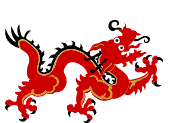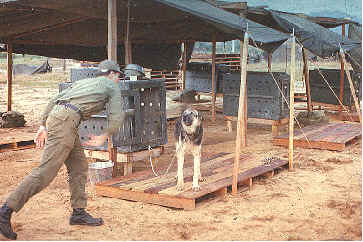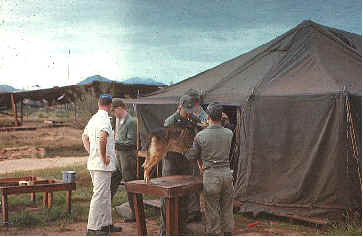It was a Sunday morning late June in 1965 when our First Sergeant, Sergeant Hutchinson, called Mike Glines and myself to his home on base. Not having a clue why we were a little concern, especially, it being a Sunday. When we arrived he escorted us to his kitchen and poured us a cup of coffee. Imagine a first shirt serving a couple of peon's coffee. He gathered the morning Sunday paper on the kitchen table and thumped his finger several times on the headlines of a North Vietnamese infiltration at the Da Nang AB Air Base. "I'll bet that is where you two are headed" he said. We both had volunteered several weeks ago and had forgotten all about it. Our first shirt had a unique way of reminding us that we had. A few days later we received our orders that we were to report with dogs NLT 1600, 10 Jul 65 to Sentry Dog School, Lackland AFB, TX. (I still have copies). There were forty teams from all over the U.S. at Lackland being evaluated for Operation Top Dog XLV. The instructors seeing Mike's dog quickly informed him that he has to get acquainted with a new dog because his dog King 737F was all white. King may have been the first Vietnam reject. Remember at that time the dogs were Sentry dogs and getting acquainted in a short time frame was not easy. Mike had very little time to get that up/down the leash relationship established and going into an unknown situation without a good read on his dog was going to be tough. There was not a class of new handlers being trained at that time so there were many instructors working with us. Les Maddox (366th Da Nang AB) used to catch rattle snakes in civilian life, so being in Texas it was quite natural for him to snare a couple. One of the instructors was deadly afraid of snakes so he and Les did not get along. One evening when we came back from being decoys, Les has a rattler in one hand the head in the other and about four feet of snake hanging between. The instructor seeing Les and I come in with the snake blew a gasket and if he had had a sidearm I'm sure he would have drew down on us. Les snapped the rattler like you would a whip and popped the head off with a loud pop. The instructors ran us through several night training sessions none of which were what we found when we arrived in country. But, how do you simulate Vietnam. Big on their agenda were retraining our dogs not to agitate on gunfire. Of all they put us though, trying to brake my dog of not barking on gunfire was the hardest. Dutch loved gunfire but he learned to like it quietly. If there was a fire fight on the perimeter he was in heaven and was more alert. After our testing/training twenty teams (I have pictures if any readers are from the first team) were loaded up and shipped out. The rest of us left a few days later on a C130. The flight over was uneventful except the leg from Texas to the West Coast. One engine lost a generator so the pilot shut it down. Every where we landed the Air Police roped off our aircraft and posted guards. We were allowed to exercise the dogs at each stop, which caused quite a stir when twenty handlers each with a dog were seen exiting the aircraft. Da Nang AB First Night Our sergeant, whose name escapes me, and I did not agree on the care of my dog on the flight over. He wanted me to give Dutch the pills the vets had given us to keep them calm. I refused so upon arrival I was assigned the first CQ duty. Most of our dogs were lodged in a large tent with their shipping crates as their doghouse. The crates were turned upside down secured to a pallet and the stake chain attached to the handle. There were kennels available for our dogs but they were not in very good condition and needed some work before we could use them. Our kennel office was also a tent with a couple of cots and this is where my first night in Da Nang AB was spent. We had arrived before dark and gotten our dogs and gear secured when the sergeant assigned me to CQ duty while the rest of the handlers were trucked off to tent city to find out where we were to live. A Marine Sergeant Major (that was also his name) showed up carrying a box of grenades. He informed me that they were expecting some activity that evening but not to be alarmed. Sure a sky cop dog handler without a stitch of combat training and he wants me not to be "alarmed". He also asked if I had any ammo for my 16, which I didn't and when I told him so I swear he sighed with relief. The Sergeant Major also was kind enough to point out where the bunker was if I needed to take cover. Little did I know that he was setting me up because just about every night a very large cannon was letting lose some very large shells in support of the Army and Marines. Upon returning from the bunker guess who was waiting for me with a large grin and a cup of coffee. By the way the grenades were of the smoke variety. Little did I know that our kennel area was in the middle of three or four thousand Marines and our dogs were in the most secure area in Da Nang AB. Thanks guys! We found out very quickly that working a sentry dog in Vietnam was not like working them in the States with just you and your dog on your assigned post. Some areas we worked had Army guarding fuel depots, Marines in foxholes around the perimeter, the Air Force with walking sentries on the aircraft and K-9 teams slotted somewhere in between. And for the first time our dogs were exposed to gunfire either on the perimeter or a firefight within hearing distance. The first night on duty I observed a Marine Officer going from foxhole to foxhole checking the Marine's weapon for a live round in the chamber. You could always tell when the officer was in the area because the Marines in the foxholes would silently remove the live round before the officer showed up then when he was out of hearing range they quietly charged their weapons up again. After the officer left I approached the fence between us and asked why. The Marine informed me that they were not allowed to chamber a round until fired on. Remember this was July 1965 and it wasn't long before they got rid of that silly reg. After a while our dogs adjusted to this type of activity.
Photo Above: The first temporary kennels. The dogs were staked to their shipping crates using chains & collars. Wood pallets were used to raise the dogs above the mud during monsoon.
|



